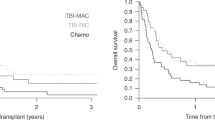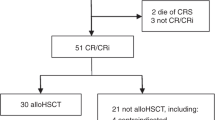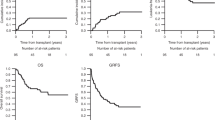Abstract
Adult patients with acute lymphoblastic leukemia (ALL) and t(1;19)/E2A-PBX1 or t(4;11)/MLL-AF4 have a poor outcome. We have evaluated the impact of an intensified post-remission therapy using a high-dose chemotherapy course followed by allogeneic or autologous SCT on the outcome of 58 patients with t(1;19)/E2A-PBX1 (E2A group, n=24) or t(4;11)/MLL-AF4 (MLL group, n=34) treated in the LALA-94 multicenter prospective study. Patients in the MLL group had higher WBC counts and more frequent DIC. CR rates achieved by MLL and E2A groups were similar to other B-cell ALL (87, 82 and 86% respectively). While in CR, patients with a donor were assigned to alloSCT (n=22), the remaining patients with were randomized between autoSCT (n=15) or chemotherapy (n=8). Five-year overall survival was 31 and 45% for E2A and MLL groups, respectively. In both groups, DFS was higher in the alloSCT arm as compared to autoSCT and chemotherapy arms. The results of this study show that chemotherapy intensification did not overcome the poor prognosis of adults with t(1;19)/E2A-PBX1. Allogeneic SCT should thus be offered in first CR to patients with t(1;19)/E2A-PBX1 or t(4;11)/MLL-AF4. New therapeutic approaches are needed for patients without donor.
This is a preview of subscription content, access via your institution
Access options
Subscribe to this journal
Receive 12 print issues and online access
$259.00 per year
only $21.58 per issue
Buy this article
- Purchase on Springer Link
- Instant access to full article PDF
Prices may be subject to local taxes which are calculated during checkout



Similar content being viewed by others
References
Kantarjian HM, O'Brien S, Smith TL, Cortes J, Giles FJ, Beran M et al. Results of treatment with hyper-CVAD, a dose-intensive regimen, in adult acute lymphocytic leukemia. J Clin Oncol 2000; 18: 547–561.
Fiere D, Lepage E, Sebban C, Boucheix C, Gisselbrecht C, Vernant JP et al. Adult acute lymphoblastic leukemia: a multicentric randomized trial testing bone marrow transplantation as postremission therapy. The French Group on Therapy for Adult Acute Lymphoblastic Leukemia. J Clin Oncol 1993; 11: 1990–2001.
Larson RA, Dodge RK, Burns CP, Lee EJ, Stone RM, Schulman P et al. A five-drug remission induction regimen with intensive consolidation for adults with acute lymphoblastic leukemia: cancer and leukemia group B study 8811. Blood 1995; 85: 2025–2037.
Gokbuget N, Hoelzer D, Arnold R, Bohme A, Bartram CR, Freund M et al. Treatment of Adult ALL according to protocols of the German Multicenter Study Group for Adult ALL (GMALL). Hematol Oncol Clin North Am 2000; 14: 1307–1325, ix.
Hoelzer D, Thiel E, Loffler H, Buchner T, Ganser A, Heil G et al. Prognostic factors in a multicenter study for treatment of acute lymphoblastic leukemia in adults. Blood 1988; 71: 123–131.
Hoelzer D, Ludwig WD, Thiel E, Gassmann W, Loffler H, Fonatsch C et al. Improved outcome in adult B-cell acute lymphoblastic leukemia. Blood 1996; 87: 495–508.
Ludwig WD, Rieder H, Bartram CR, Heinze B, Schwartz S, Gassmann W et al. Immunophenotypic and genotypic features, clinical characteristics, and treatment outcome of adult pro-B acute lymphoblastic leukemia: results of the German multicenter trials GMALL 03/87 and 04/89. Blood 1998; 92: 1898–1909.
Ribera JM, Ortega JJ, Oriol A, Granada I, Hernandez-Rivas JM, Parody R et al. Prognostic value of karyotypic analysis in children and adults with high-risk acute lymphoblastic leukemia included in the PETHEMA ALL-93 trial. Haematologica 2002; 87: 154–166.
Secker-Walker LM, Prentice HG, Durrant J, Richards S, Hall E, Harrison G . Cytogenetics adds independent prognostic information in adults with acute lymphoblastic leukaemia on MRC trial UKALL XA. MRC Adult Leukaemia Working Party. Br J Haematol 1997; 96: 601–610.
Wetzler M, Dodge RK, Mrozek K, Carroll AJ, Tantravahi R, Block AW et al. Prospective karyotype analysis in adult acute lymphoblastic leukemia: the cancer and leukemia Group B experience. Blood 1999; 93: 3983–3993.
A Collaborative Study of the Group Francais de Cytogenetique Hematologique. Cytogenetic abnormalities in adult acute lymphoblastic leukemia: correlations with hematologic findings outcome. Blood 1996; 87: 3135–3142.
Dombret H, Gabert J, Boiron JM, Rigal-Huguet F, Blaise D, Thomas X et al. Outcome of treatment in adults with Philadelphia chromosome-positive acute lymphoblastic leukaemia-results of the prospective multicenter LALA-94 trial. Blood 2002; 100: 2357–2366.
Ottmann OG, Druker BJ, Sawyers CL, Goldman JM, Reiffers J, Silver RT et al. A phase 2 study of imatinib in patients with relapsed or refractory Philadelphia chromosome-positive acute lymphoid leukemias. Blood 2002; 100: 1965–1971.
Druker BJ, Sawyers CL, Kantarjian H, Resta DJ, Reese SF, Ford JM et al. Activity of a specific inhibitor of the BCR-ABL tyrosine kinase in the blast crisis of chronic myeloid leukemia and acute lymphoblastic leukemia with the Philadelphia chromosome. N Engl J Med 2001; 344: 1038–1042.
Faderl S, Jeha S, Kantarjian HM . The biology and therapy of adult acute lymphoblastic leukemia. Cancer 2003; 98: 1337–1354.
Pui CH, Evans WE . Acute lymphoblastic leukemia. N Engl J Med 1998; 339: 605–615.
Raimondi SC, Behm FG, Roberson PK, Williams DL, Pui CH, Crist WM et al. Cytogenetics of pre-B-cell acute lymphoblastic leukemia with emphasis on prognostic implications of the t(1;19). J Clin Oncol 1990; 8: 1380–1388.
Thomas X, Boiron JM, Huguet F, Dombret H, Bradstock K, Vey N et al. Outcome of treatment in adults with acute lymphoblastic leukemia: analysis of the LALA-94 trial. J Clin Oncol 2004; 22: 4075–4086.
Biondi A, Rambaldi A, Rossi V, Elia L, Caslini C, Basso G et al. Detection of ALL-1/AF4 fusion transcript by reverse transcription-polymerase chain reaction for diagnosis and monitoring of acute leukemias with the t(4;11) translocation. Blood 1993; 82: 2943–2947.
Hunger SP, Galili N, Carroll AJ, Crist WM, Link MP, Cleary ML . The t(1;19)(q23;p13) results in consistent fusion of E2A and PBX1 coding sequences in acute lymphoblastic leukemias. Blood 1991; 77: 687–693.
Troussard X, Rimokh R, Valensi F, Leboeuf D, Fenneteau O, Guitard AM et al. Heterogeneity of t(1;19)(q23;p13) acute leukaemias. French Haematological Cytology Group. Br J Haematol 1995; 89: 516–526.
van Dongen JJ, Macintyre EA, Gabert JA, Delabesse E, Rossi V, Saglio G et al. Standardized RT-PCR analysis of fusion gene transcripts from chromosome aberrations in acute leukemia for detection of minimal residual disease. Report of the BIOMED-1 Concerted Action: investigation of minimal residual disease in acute leukemia. Leukemia 1999; 13: 1901–1928.
Beillard E, Pallisgaard N, van der Velden VH, Bi W, Dee R, van der Schoot E et al. Evaluation of candidate control genes for diagnosis and residual disease detection in leukemic patients using ‘real-time’ quantitative reverse-transcriptase polymerase chain reaction (RQ-PCR) – a Europe against cancer program. Leukemia 2003; 17: 2474–2486.
Gabert J, Beillard E, van der Velden VH, Bi W, Grimwade D, Pallisgaard N et al. Standardization and quality control studies of ‘real-time’ quantitative reverse transcriptase polymerase chain reaction of fusion gene transcripts for residual disease detection in leukemia – a Europe Against Cancer program. Leukemia 2003; 17: 2318–2357.
Bene MC, Castoldi G, Knapp W, Ludwig WD, Matutes E, Orfao A et al. Proposals for the immunological classification of acute leukemias. European Group for the Immunological Characterization of Leukemias (EGIL). Leukemia 1995; 9: 1783–1786.
Hunger SP, Fall MZ, Camitta BM, Carroll AJ, Link MP, Lauer SJ et al. E2A-PBX1 chimeric transcript status at end of consolidation is not predictive of treatment outcome in childhood acute lymphoblastic leukemias with a t(1;19)(q23;p13): a Pediatric Oncology Group study. Blood 1998; 91: 1021–1028.
Izraeli S, Janssen JW, Haas OA, Harbott J, Brok-Simoni F, Walther JU et al. Detection and clinical relevance of genetic abnormalities in pediatric acute lymphoblastic leukemia: a comparison between cytogenetic and polymerase chain reaction analyses. Leukemia 1993; 7: 671–678.
Crist WM, Carroll AJ, Shuster JJ, Behm FG, Whitehead M, Vietti TJ et al. Poor prognosis of children with pre-B acute lymphoblastic leukemia is associated with the t(1;19)(q23;p13): a Pediatric Oncology Group study. Blood 1990; 76: 117–122.
Foa R, Vitale A, Mancini M, Cuneo A, Mecucci C, Elia L et al. E2A-PBX1 fusion in adult acute lymphoblastic leukaemia: biological and clinical features. Br J Haematol 2003; 120: 484–487.
Boissel N, Auclerc MF, Lheritier V, Perel Y, Thomas X, Leblanc T et al. Should adolescents with acute lymphoblastic leukemia be treated as old children or young adults? Comparison of the French FRALLE-93 and LALA-94 trials. J Clin Oncol 2003; 21: 774–780.
Jeha S . Who should be treating adolescents and young adults with acute lymphoblastic leukaemia? Eur J Cancer 2003; 39: 2579–2583.
Johansson B, Moorman AV, Haas OA, Watmore AE, Cheung KL, Swanton S et al. Hematologic malignancies with t(4;11)(q21;q23)--a cytogenetic, morphologic, immunophenotypic and clinical study of 183 cases. European 11q23 Workshop participants. Leukemia 1998; 12: 779–787.
Armstrong SA, Staunton JE, Silverman LB, Pieters R, den Boer ML, Minden MD et al. MLL translocations specify a distinct gene expression profile that distinguishes a unique leukemia. Nat Genet 2002; 30: 41–47.
Schnittger S, Weisser M, Schoch C, Hiddemann W, Haferlach T, Kern W . New score predicting for prognosis in PML-RARA+, AML1-ETO+, or CBFBMYH11+ acute myeloid leukemia based on quantification of fusion transcripts. Blood 2003; 102: 2746–2755.
Pui CH, Gaynon PS, Boyett JM, Chessells JM, Baruchel A, Kamps W et al. Outcome of treatment in childhood acute lymphoblastic leukaemia with rearrangements of the 11q23 chromosomal region. Lancet 2002; 359: 1909–1915.
Acknowledgements
This work was supported in part by PHRC No. 94-95-97-02, Ministère de l'Emploi et de la Solidarité. The authors are indebt to Véronique Lheritier for excellent data management, MC Benet for paper review and to the following investigators of the LALA-94 trials: F Guilhot (CHU Poitiers), X Vallantin (CH Perpignan), N Fégueux (CHU Montpellier), B Souleau (HIA Percy), F Garban (CHU Grenoble), C Caillot (Dijon) and O Boulat (Avignon).
Author information
Authors and Affiliations
Consortia
Corresponding author
Rights and permissions
About this article
Cite this article
Vey, N., Thomas, X., Picard, C. et al. Allogeneic stem cell transplantation improves the outcome of adults with t(1;19)/E2A-PBX1 and t(4;11)/MLL-AF4 positive B-cell acute lymphoblastic leukemia: results of the prospective multicenter LALA-94 study. Leukemia 20, 2155–2161 (2006). https://doi.org/10.1038/sj.leu.2404420
Received:
Revised:
Accepted:
Published:
Issue Date:
DOI: https://doi.org/10.1038/sj.leu.2404420
Keywords
This article is cited by
-
Therapeutic implications of menin inhibition in acute leukemias
Leukemia (2021)
-
Acute Lymphoblastic Leukemia and Acute Lymphoblastic Lymphoma: Same Disease Spectrum but Two Distinct Diagnoses
Current Hematologic Malignancy Reports (2021)
-
Consolidative allogeneic hematopoietic stem cell transplantation after chimeric antigen receptor T-cell therapy for relapsed/refractory B-cell acute lymphoblastic leukemia: who? When? Why?
Biomarker Research (2020)
-
Allogeneic hematopoietic stem cell transplantation for adult patients with B-cell acute lymphoblastic leukemia harboring t(1;19)(q23;p13.3); comparison with normal karyotype
Bone Marrow Transplantation (2020)
-
MLL-Rearranged Acute Lymphoblastic Leukemia
Current Hematologic Malignancy Reports (2020)



